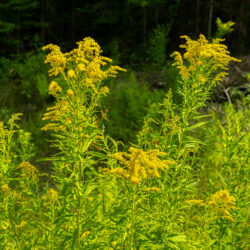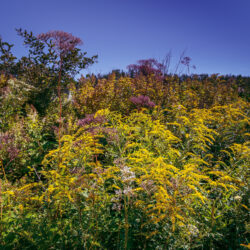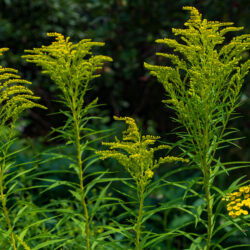Etymology
Solidago is from Latin solidus/solido (whole) and ago (to make), in reference to the plants’ supposed healing properties; canadensis is Latin, referring to its native Canadian habitat.
Native Habitat
Fields, meadows, open woodlands.
Garden Uses
Blooming at the same time as Joe Pye weed and asters, Canada goldenrod is a useful addition in the fall garden.
Overview
The Goldenrods can be a tough species to crack, 18 of the 100+ species are native to Maine. Canada Goldenrod is usually 2 - 4’ tall, but can be as tall as 6’ and is often found growing in large colonies due to its spread by rhizomes as well as by seeds. Canada goldenrod is a perennial plant with bright yellow flowers from late summer to early fall – the same time of year as ragweed, which is the culprit causing the symptoms suffered by those with allergies. Canada goldenrod is usually found in full sun in fields, roadsides open woodlands and wetland edges.
Leaves and Stems
Leaves are lance shaped, alternate, 2- 7 ½” long and ¼ – 1 ¼” wide. They are broadest at the middle and taper at both ends. The leaf edges are mostly sharply toothed except near the leaf base, though leaves may be toothless or nearly so just below the flower cluster. Leaves are largest around mid-stem, somewhat smaller above, and lower stem leaves have often withered away by flowering time. The stems are erect and rigid with short hairs from the flower cluster to about mid-stem, then sparsely hairy to hairless toward the base. Plants can have single stems or up to 20 stems in a group from underground creeping rhizomes.
Flowers
The branching cluster of taxi-cab yellow flowers at the top of the plant are basically pyramidal in shape, although they can be very broadly spreading or more cascading. Each plant can have between 100 and 1,300 individual flowers in the cluster. The flowers are about 1/8 inch across with usually 8 to 15 petals (ray flowers) surrounding a center disc with usually 3 to 6 disc-shaped flowers.
Fruit/Seed
The fruit is a brown, sparsely hairy, oblong to narrowly cone-shaped tiny seed (achene) with a tuft of whitish hairs attached at the tip to carry it off in the wind.
Animal Associates
Canada goldenrod attracts a large number of native bees and honeybees as well as predatory and parasitoid insects that prey upon pest insects. Migrating birds feast on the seeds in the fall and small mammals eat them throughout the winter.
Propagation
May be grown from seed.
Ethnobotanical Uses
There are a multitude of herbal remedies made from all parts of Goldenrod. It has been used to treat wounds, allergies, TB, arthritis, asthma, hypertension and as a diuretic.
Anecdotal Information
Canada goldenrod was used during WWII to make a much-needed rubber substitute. There is some evidence that it may be allelopathic to sugar maple (Acer saccharum) seedlings, meaning it produces chemicals in the soil that inhibits their growth.
Sources
UConn Home and Garden Education Center
Lady Bird Johnson Wildflower Center
North Carolina Cooperative Extension Service
Plant Profile by Kathy Kling



